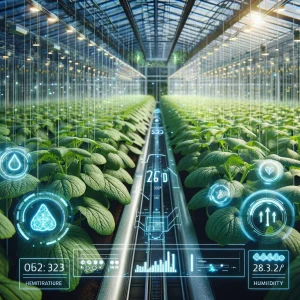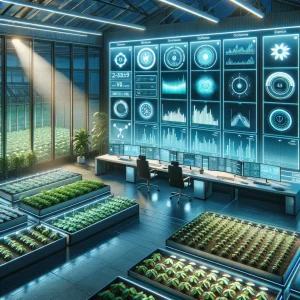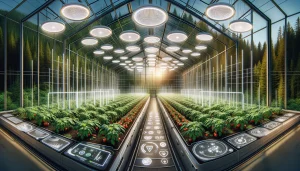In British Columbia, where the climate can vary dramatically, commercial landscapers and agricultural developers face the challenge of maintaining optimal plant growth throughout the year. Enter smart greenhouses — a solution that propels the farming industry into the future and ensures that plants thrive in controlled, technologically advanced environments.

Embracing Technology for Growth
Smart greenhouses integrate cutting-edge technologies to create environments perfectly tailored for plant growth. Key among these technologies are automated climate control systems and smart LED lighting, which adjust conditions inside the greenhouse based on real-time data. For example, during unexpected cold snaps, the climate control system can increase the heat and adjust the humidity levels to ensure plants remain at their peak health.
LED lighting provides another layer of control by supplementing sunlight, ensuring that plants receive the precise light spectrum needed for photosynthesis, regardless of external weather conditions. This is particularly beneficial during British Columbia’s long winters, where sunlight is scarce.

Case Studies: Tomatoes and Cucumbers
Consider the success stories of local commercial farms growing tomatoes and cucumbers, two crops that benefit from smart greenhouse conditions. These farms have consistently reported higher yields and superior quality than traditional farming methods. The controlled environment reduces common problems such as pest infestations and plant diseases, which are prevalent in open-air farms.
Tomatoes, for instance, are sensitive to temperature fluctuations, which can affect their growth cycle and fruit quality. Smart greenhouses maintain a consistent temperature ideal for tomato cultivation, resulting in robust growth and earlier harvesting opportunities. Similarly, cucumbers, which require high humidity levels, benefit immensely from the moisture control provided by these advanced systems.

Overcoming Environmental Challenges
Smart greenhouses are adept at addressing environmental challenges such as fluctuating temperatures and limited water resources. By recycling water through advanced irrigation systems, these greenhouses ensure that water use is optimized and waste is minimized. This is crucial in areas where water conservation is essential.
Moreover, controlling environmental factors means that plants can be grown year-round, increasing productivity and sustainability in agricultural practices. This is a significant advantage in British Columbia, where seasonal variations hamper traditional outdoor farming.

Future Trends and Implementing Smart Technologies
Looking forward, the trend in smart greenhouse technology is leaning towards even greater automation and integration of artificial intelligence. These advancements will likely include more sophisticated sensors to monitor plant health at a micro level and automated systems that can predict plant needs before they become apparent.
For commercial landscapers and agricultural students eager to implement smart greenhouse technologies, starting with a thorough assessment of their specific environmental conditions and crop needs is essential. Investing in quality technology and training staff to manage these systems effectively is also crucial.
Smart greenhouses represent a significant leap forward for commercial landscaping and agriculture in British Columbia. By harnessing technology to create ideal growing conditions, these facilities are setting new standards for productivity and efficiency in agriculture. As we look to the future, integrating more advanced technologies promises to enhance the capabilities of smart greenhouses further, making them an indispensable tool in the fight to achieve sustainable agriculture and food security.